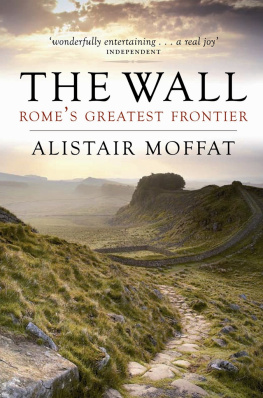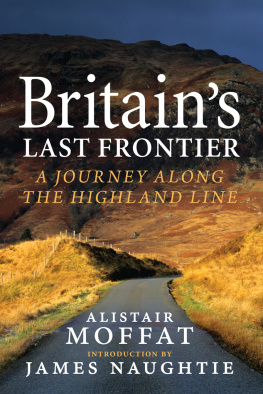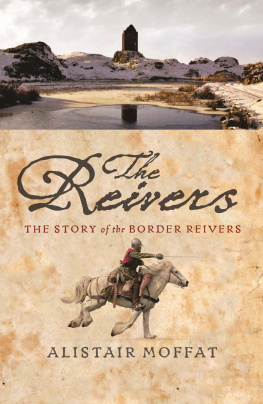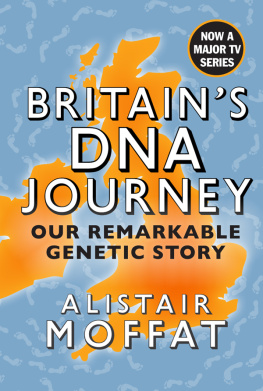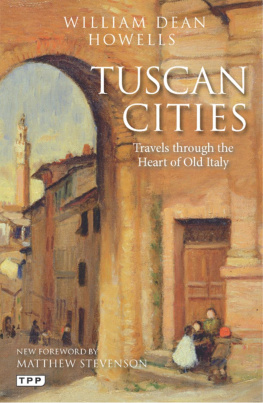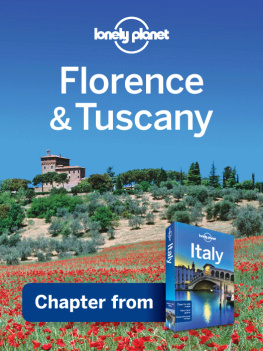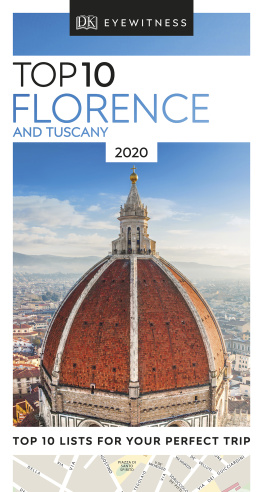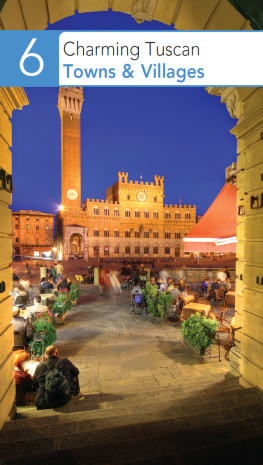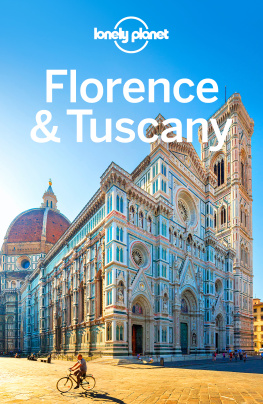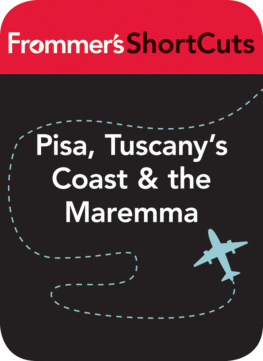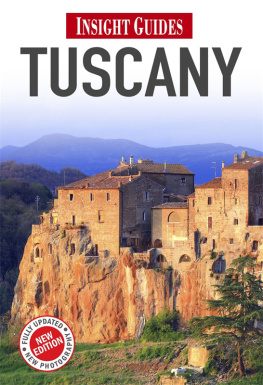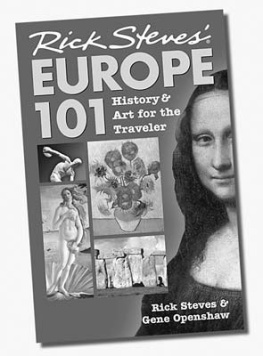This edition published in 2011 by
Birlinn Limited
West Newington House
10 Newington Road
Edinburgh
EH9 1QS
www.birlinn.co.uk
Copyright Alistair Moffat 2009
Phographs copyright Liz Hanson 2009
The moral right of Alistair Moffat to be identified as the author of this work has been asserted by him in accordance with the Copyright, Designs and Patents Act 1988
All rights reserved. No part of this publication may be reproduced, stored or transmitted in any form without the express written permission of the publisher.
ISBN: 978 1 84158 860 5
e-book ISBN: 978 0 85790 056 2
British Library Cataloguing-in-Publication Data
A catalogue record for this book is available from the British Library
Typeset by Hewer Text UK Ltd, Edinburgh
Printed and bound by CPI, Cox & Wyman
List of Illustrations
Morning in Pitigliano, the sun lighting the site of the Etruscan citadel.
Pitigliano seems to grow directly out of its tufa cliffs.
The Medici aqueduct and the Orsini fortress at Pitigliano.
A narrow medieval lane in Pitigliano.
No doubt where the prosciutto came from in this Tuscan butchers shop.
Monumental Etruscan tombs carved from the living tufa near Sovana.
Niches from one of the complexes of Etruscan tombs in southern Tuscany.
The massive walls of Tarquinia, built on Etruscan foundations.
One of the medieval towers of Tarquinia.
Bolsena, the new city of the Volsinii on Lake Bolsena.
The narrow lanes of medieval Bolsena.
Fiesole, the Etruscan city in the hills north of Florence.
The Roman/Etruscan gateway into Saturnia, the terminus of the Via Clodia.
The flagpole at the top is the sole perpendicular line on the leaning tower of Pisa.
The beautiful early medieval cathedral of Pisa and its leaning bell tower.
Ornate architecture in the city of Pisa shows its ancient prosperity.
Madonna and Child at S. Michele in Foro, Lucca.
The courtyard at Pisa Town Hall.
The Arno flows lazily through Pisa.
Pisan defence works by the Arno.
Massive defences kept Lucca independent for many centuries.
Now glazed and decorated, this gateway is one of four guarding access to Lucca.
The portcullis still survives.
The magnificent town hall, the Palazzo Pubblico, of Siena in the Campo.
The Palio, the great annual horse race, is run around the perimeter of the Campo.
A bronze sculpture in Siena of Romulus and Remus being suckled by the She-wolf.
The gorgeously decorated faade of Siena Cathedral.
A elaborate portal to an inner courtyard off one of Sienas narrow streets.
The famous medieval towers of San Gimignano.
The Florentine skyline. Above the line of the Arno, the Palazzo Vecchio and the cathedral.
The Franciscan church of Santa Croce in Florence.
Brunelleschis dome for Florence Cathedral.
Rich decoration on the faade of Florence Cathedral.
Florence Cathedral and its bell tower, designed by Giotto.
A view looking down the Arno as it flows west through Florence.
Some vestiges of Florences massive defences remain.
Michelangelos David, the copy in the Piazza della Signoria.
The Ponte Vecchio with the windows of the Corridoio Vasariano on the 1st floor.
The town hall at Montepulciano.
The medieval streets of Montepulciano.
The villa of La Foce, the wartime home of Iris Origo and her family.
The lush produce of Tuscan farmland and market gardens.
The butcher shop in Pitigliano run by the Polidori family.
Four views of the intensively cultivated and stunningly beautiful countryside of Tuscany.
Acknowledgements
In the late summer of 1971 I found myself in Romes main line station very early in the morning looking for the platform for trains to Florence, or Firenze, as I discovered just in time. Almost forty years ago, in what seems like another life, I was an undergraduate at St Andrews University. Astonishing now to relate in these days of student debts and huge tuition fees, the Scottish Education Department paid for everything, all fees and a maintenance grant of 300 a year. And even more astonishing to relate, St Andrews University were about to pay for my trip to Florence, or Firenze, and give me a further grant for six weeks so that I could learn Italian and look at the great buildings, paintings and sculpture of Tuscany. My travel, bed and breakfast were all paid for, there was an immersion course in Italian every weekday morning and I was to receive 1,500 lire a day for subsistence.
Astonishing, but in 1971 education was still going on in Britain and Italy, for anyone who could pass the exams, and all of that was considered to be not a privilege but an essential part of studying the Italian Renaissance the ability to go and see its great achievements for yourself, whoever you were. For a young man who had been raised on a council estate, with no money past what could be earned from part-time jobs, it was the only way I could ever have beheld the marvels I discovered that summer long ago. In the Scotland of the 1960s and 70s I was lucky to receive an education for free and it is nothing less than a tragedy that very few from my background can now afford to see what I saw in the galleries, churches and streets of the great cities of Tuscany.
I had company in 1971. My oldest and dearest friend, Tom Pow, was with me and we forged a bond then which has never wavered. This book is dedicated to Tommie with much love and in memory of all the splendours we first saw together in the Tuscan sunshine. The Italian classes were a waste of time for T.P., but the Masaccios made an indelible impression.
When I left St Andrews I was extremely fortunate to be given a place as a postgraduate at London Universitys Warburg Institute. Its focus was the study of the Italian Renaissance and I had the privilege of listening to and sometimes working with very great scholars such as Michael Baxandall and Frances Yates. But most of all my tutor, Sir Ernst Gombrich, taught me how to look at works of art and not to fuss too much. Simplify, Mr Moffat, you must always seek to simplify. All the time I was writing this book, I could hear his quiet voice. I hope I listened.
Other voices require ready acknowledgement. The Insight Guide to Tuscany edited by Barbara Balletto is excellent, even enclyclopaedic, and I leaned heavily not only on the information in it but also on the keen observations. Dame Iris Origo wrote two very different accounts of Tuscan lives, The Merchant of Prato, about the fourteenth-century Francesco Datini, and her account of the Second World War as it swirled around her house and estate. War in the Val dOrcia is a superb piece of reporting and I am grateful to Allison & Busby for permission to quote from it extensively. I acknowledge substantial debts to all the authors listed in the bibliography and recommend all the books to those interested in reading further.
My agent, David Godwin, has been steadfast and sensible as ever, and he managed to persuade my publisher, Birlinn, to do something different by taking on this project. Hugh Andrew, Jan Rutherford, Andrew Simmons and Nancy Norman have all been wonderfully helpful and supportive. Visits to West Newington House are always a pleasure. Liz Hanson has once again adorned one of my books with beautiful photographs and Jim Hutcheson has conjured an atmospheric cover. Many thanks to all.




